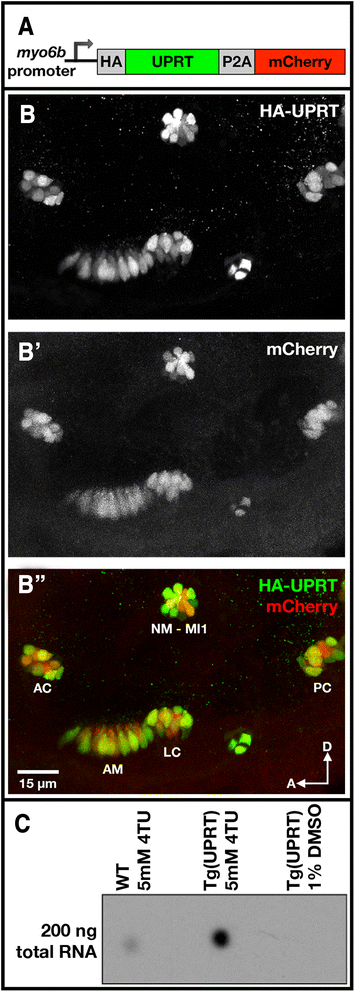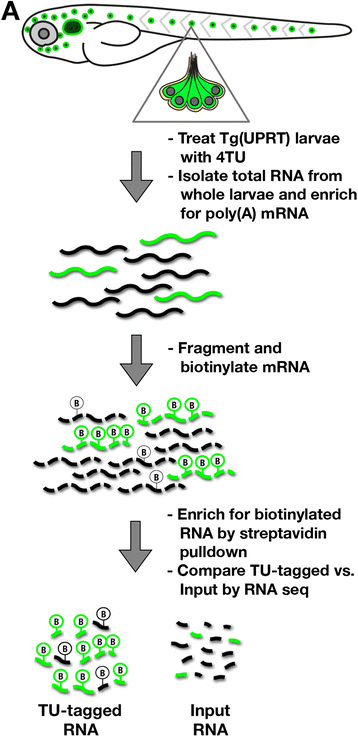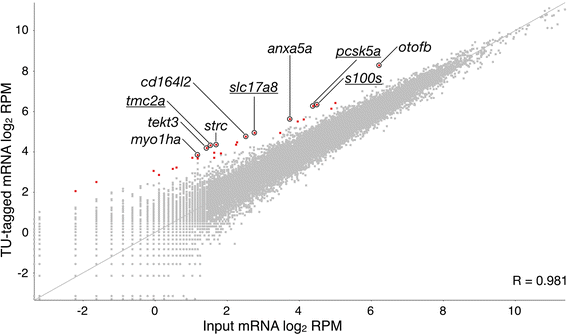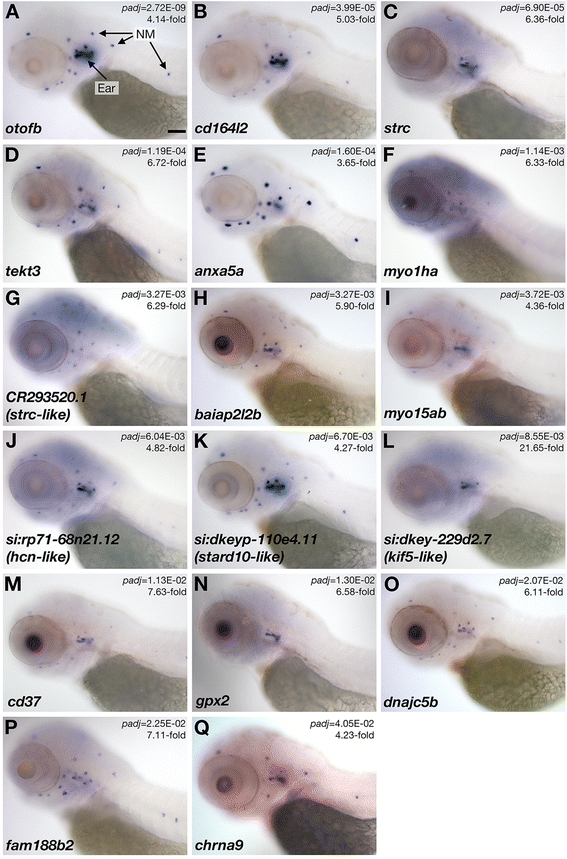Identification of sensory hair-cell transcripts by thiouracil-tagging in zebrafish
- PMID: 26494580
- PMCID: PMC4619078
- DOI: 10.1186/s12864-015-2072-5
Identification of sensory hair-cell transcripts by thiouracil-tagging in zebrafish
Abstract
Background: Sensory hair cells are exquisitely sensitive to mechanical stimuli and as such, are prone to damage and apoptosis during dissections or in vitro manipulations. Thiouracil (TU)-tagging is a noninvasive method to label cell type-specific transcripts in an intact organism, thereby meeting the challenge of how to analyze gene expression in hair cells without the need to sort cells. We adapted TU-tagging to zebrafish to identify novel transcripts expressed in the sensory hair cells of the developing acoustico-lateralis organs.
Methods: We created a transgenic line of zebrafish expressing the T.gondii uracil phospho-ribosyltransferase (UPRT) enzyme specifically in the hair cells of the inner ear and lateral line organ. RNA was labeled by exposing 3 days post-fertilization (dpf) UPRT transgenic larvae to 2.5 mM 4-thiouracil (4TU) for 15 hours. Following total RNA isolation, poly(A) mRNA enrichment, and purification of TU-tagged RNA, deep sequencing was performed on the input and TU-tagged RNA samples.
Results: Analysis of the RNA sequencing data revealed the expression of 28 transcripts that were significantly enriched (adjusted p-value < 0.05) in the UPRT TU-tagged RNA relative to the input sample. Of the 25 TU-tagged transcripts with mammalian homologs, the expression of 18 had not been previously demonstrated in zebrafish hair cells. The hair cell-restricted expression for 17 of these transcripts was confirmed by whole mount mRNA in situ hybridization in 3 dpf larvae.
Conclusions: The hair cell-restricted pattern of expression of these genes offers insight into the biology of this receptor cell type and may serve as useful markers to study the development and function of sensory hair cells. In addition, our study demonstrates the utility of TU-tagging to study nascent transcripts in specific cell types that are relatively rare in the context of the whole zebrafish larvae.
Figures




Similar articles
-
Sequencing cell-type-specific transcriptomes with SLAM-ITseq.Nat Protoc. 2019 Aug;14(8):2261-2278. doi: 10.1038/s41596-019-0179-x. Epub 2019 Jun 26. Nat Protoc. 2019. PMID: 31243395 Free PMC article.
-
Cell type-specific transcriptomic analysis by thiouracil tagging in zebrafish.Methods Cell Biol. 2016;135:309-28. doi: 10.1016/bs.mcb.2016.04.009. Epub 2016 May 4. Methods Cell Biol. 2016. PMID: 27443933
-
TU-Tagging: A Method for Identifying Layer-Enriched Neuronal Genes in Developing Mouse Visual Cortex.eNeuro. 2017 Oct 4;4(5):ENEURO.0181-17.2017. doi: 10.1523/ENEURO.0181-17.2017. eCollection 2017 Sep-Oct. eNeuro. 2017. PMID: 29085897 Free PMC article.
-
EC-tagging allows cell type-specific RNA analysis.Nucleic Acids Res. 2017 Sep 6;45(15):e138. doi: 10.1093/nar/gkx551. Nucleic Acids Res. 2017. PMID: 28641402 Free PMC article.
-
Uncovering cell type-specific complexities of gene expression and RNA metabolism by TU-tagging and EC-tagging.Wiley Interdiscip Rev Dev Biol. 2018 Jul;7(4):e315. doi: 10.1002/wdev.315. Epub 2018 Jan 25. Wiley Interdiscip Rev Dev Biol. 2018. PMID: 29369522 Review.
Cited by
-
Motor Behavior Selectively Inhibits Hair Cells Activated by Forward Motion in the Lateral Line of Zebrafish.Curr Biol. 2020 Jan 6;30(1):150-157.e3. doi: 10.1016/j.cub.2019.11.020. Epub 2019 Dec 19. Curr Biol. 2020. PMID: 31866371 Free PMC article.
-
Regulation of the apical extension morphogenesis tunes the mechanosensory response of microvilliated neurons.PLoS Biol. 2019 Apr 19;17(4):e3000235. doi: 10.1371/journal.pbio.3000235. eCollection 2019 Apr. PLoS Biol. 2019. PMID: 31002663 Free PMC article.
-
Regionalized Protein Localization Domains in the Zebrafish Hair Cell Kinocilium.J Dev Biol. 2023 Jun 16;11(2):28. doi: 10.3390/jdb11020028. J Dev Biol. 2023. PMID: 37367482 Free PMC article.
-
The morphological and functional diversity of apical microvilli.J Anat. 2023 Mar;242(3):327-353. doi: 10.1111/joa.13781. Epub 2022 Oct 25. J Anat. 2023. PMID: 36281951 Free PMC article. Review.
-
The Cholinergic Lateral Line Efferent Synapse: Structural, Functional and Molecular Similarities With Those of the Cochlea.Front Cell Neurosci. 2021 Oct 12;15:765083. doi: 10.3389/fncel.2021.765083. eCollection 2021. Front Cell Neurosci. 2021. PMID: 34712122 Free PMC article. Review.
References
-
- SHIELD: Shared Harvard Inner-Ear Laboratory Database. [https://shield.hms.harvard.edu/].
Publication types
MeSH terms
Substances
Grants and funding
LinkOut - more resources
Full Text Sources
Other Literature Sources
Molecular Biology Databases

